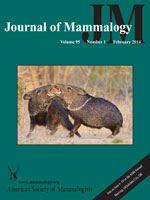A new living species of the desert-adapted tetraploid rodent Tympanoctomys (Caviomorpha, Octodontidae) is described. The new form is restricted to the type locality in Chubut Province, central Patagonia, Argentina, although is known from at least 4 additional Holocene-aged localities along the middle and lower valley of the Chubut River. Tympanoctomys sp. nov. is smaller than the living T. barrerae, its general coloration is yellowish (reddish in T. barrerae) and its tail is equal to ∼43–50% of head and body length (∼49–53% in T. barrerae). Its skull and dentition are characterized by a unique combination of morphological traits, including narrow and posteriorly acuminate nasals (broad and barrel-shaped in T. barrerae), supraoccipital not laterally expanded (expanded in T. barrerae), and 8-shaped lower 3rd molar (comma-shaped in T. barrerae and †T. cordubensis). Morphometric and genetic evidence supports the specific distinction of this Patagonian endemic Tympanoctomys, also characterized by smaller sperm than T. barrerae. The reduced range of the new species, coupled with its recent extinction from the Chubut River valley and the potential impact of large uranium mining projects in central Patagonia, suggest that this species faces a severe extinction risk in the short term.
Se describe una nueva especie viviente del roedor tetraploide desertícola Tympanoctomys (Caviomorpha, Octodontidae). La nueva forma está restringida a su localidad tipo en la provincia del Chubut, Patagonia central, Argentina, si bien es conocida al menos de 4 localidades de edad Holoceno a lo largo del valle medio e inferior del río Chubut. Tympanoctomys sp. nov. es más pequeña que la viviente T. barrerae; su coloración general es amarillenta (rojiza en T. barrerae) y su cola es relativamente más corta (∼43–50% de la longitud cabeza–cuerpo versus ∼49–53% en T. barrerae); su cráneo y dentición están caracterizados por una combinación única de rasgos morfológicos, incluyendo nasales estrechos y posteriormente acuminados (anchos y con forma de barril en T. barrerae), supraoccipital no expandido lateralmente (expandido en T. barrerae) y tercer molar inferior en forma de 8 (en forma de coma en T. barrerae y †T. cordubensis). Diferencias morfométricas y genéticas robustecen la distinción específica de este Tympanoctomys patagónico endémico, también caracterizado por espermatozoides más pequeños que los de T. barrerae. Su reducido rango de distribución, en conjunción con su extinción reciente en el curso medio e inferior del río Chubut y el potencial impacto de extensivos proyectos mineros en Patagonia central sugieren que esta especie enfrenta un riesgo severo de extinción en el corto plazo.





